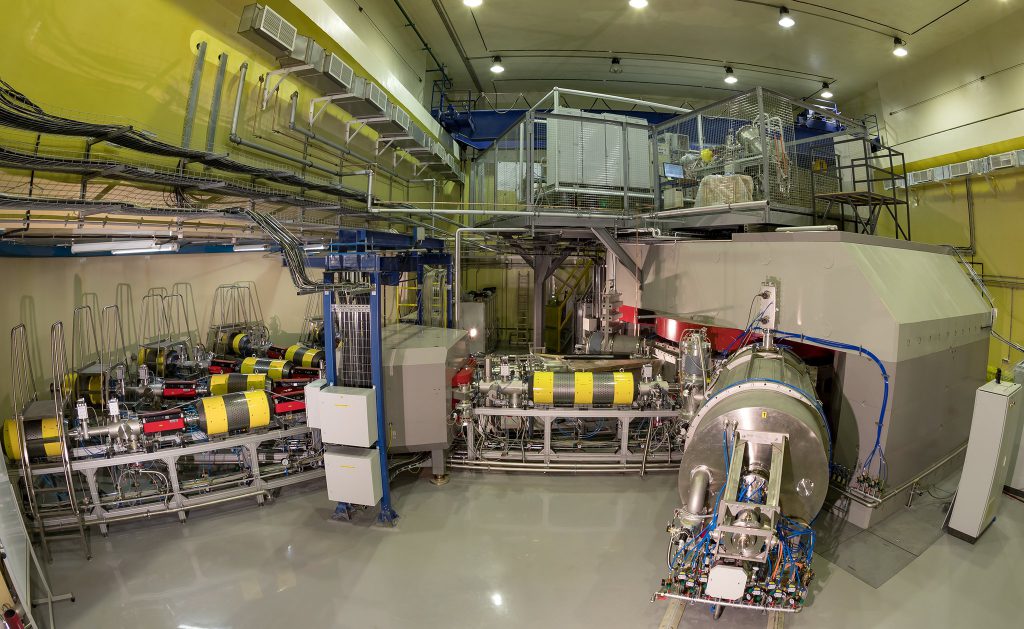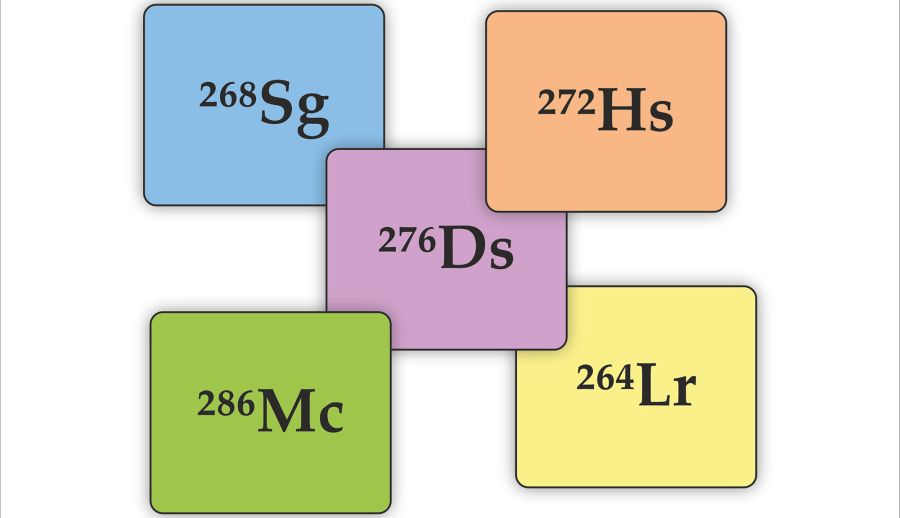SHE Factory produced five new isotopes: 264Lr, 286Mc, 276Ds, 272Hs and 268Sg
During the SHE Factory’s operation at the Laboratory of nuclear reactions in 2020 -2022 five new isotopes of superheavy elements were produced for the first time in the world: 264Lr, 286Mc, 276Ds, 272Hs and 268Sg. The fact that several unknown before isotopes were discovered during the two years of the Factory’s operation proves that this is a leading research complex setting the new standards in the field of synthesis and study of properties of superheavy elements.
Lawrencium-264 was obtained during SHE Factory first experiments where moscovium isotopes were synthesized in 48Ca+243Am reaction. The new nuclide’s lifetime was nearly five hours. This experiment repeated the reactions that already were studied earlier and not only at FLNR but also at the scientific centers in Germany, Japan, the USA.
“In the very first experiment, in these well-known and well-studied reactions as it seemed to be, we saw a new isotope of lawrencium-264. For us it indicated that SHE Factory operated as it was planned and surpassed the setups of the previous generation in its capabilities”, – commented Alexander Karpov, FLNR Scientific secretary. He added that good background conditions in the focal plane of DGFRS-II (Dubna Gas-Filled Recoil Separator), SHE Factory first separator, were the most important factor in discovery of lawrencium-264. It is able to filter out very effectively the events not related to the synthesis of superheavy elements. According to the scientist, it was previously believed that moscovium-288 decay followed the chain of several alpha decays and ended with the spontaneous fission of dubnium-268 in about 24 hours. But FLNR scientists discovered that almost in half of the events dubnium fissioned indeed but in the remaining ~50 % of events – emitted alpha-particle, producing lawrencium-264 which wasn’t observed before. About 50 events of 264Lr production out of 110 events of 288Mc were recorded.
Another remarkable feature of SHE Factory is its high performance which allows to collect statistics much faster. Thus sometimes we manage to study a reaction at several beam energies in one experiment working with extremely low cross-sections (probabilities) which makes it possible to get absolutely new information. So in 2021 there was one event of new moscovium-286 isotope at SHE Factory and its lifetime is only 20 milliseconds. “We managed to discover this isotope only thanks to the fact that now statistics is collected much faster than before”,- noted Alexander Karpov.
In 2022 experiment a reaction was used that had not been studied yet anywhere in the world – interaction of calcium-48 beam with thorium-232 target material. Three unknown before isotopes were obtained in this combination at once: darmstadtium-276 (six events), hassium-272 and siborgium-268 (two events each). It turned out that darmstadtium-276 undergoes alpha decays into hassium-272 in some fractions of a second and hassium in its turn undergoes alpha decays into seborgium-268 in a hundred milliseconds which during 10-15 seconds spontaneously fissions.
Preparation for the synthesis of element 120 of the Periodic Table is the main purpose of this experiment. Theory predicts that minimum cross section was expected for the calcium-thorium reaction. Cross sections in calcium-48 reaction increase both when moving to lighter elements and to heavier ones. For element 110, darmstadtium, its minimum was predicted by theory. “It was very important to try to synthesize at the Factory a nucleus for which the survival rate is expected to be even lower than for element 120 to demonstrate that we are able to perform experiments with very low cross sections. Lower than we have worked so far. And it was also a success”,- explained Alexander Karpov.
Another fact which was very important to study is that the isotopes of element 120 which may be produced in one of the possible fusion reactions will go along decay chain through darmstadtium-276, hassium-272 and seborgium-268. “That’s why it was very important to get these nuclei separately, study their properties so that later when observing the fusion events of element 120 we were absolutely sure that we identified nuclei correctly”,- said Alexander Karpov.
FLNR plan to continue the study of the calcium-thorium reaction in spring 2023 only at higher beam energy. One may hope both for refining properties of just discovered darmstadtium-276 and for the synthesis of others unknown yet isotopes of this element such as darmstadtium-275 or darmstadtium-274.
“Five new isotopes over two years of work means that SHE Factory is indeed an extra-class complex for the synthesis and study of superheavy elements”,- said FLNR Scientific secretary. Parameters of both the Factory accelerator and the separators were initially adjusted for the most efficient solution of SHE physics and chemistry tasks. “All our experience in creation of accelerators and separators accumulated over the previous decades, taking into account all ideas for improving parameters of the facilities was put into this accelerator complex. Actually we did our 100% best”,- said Alexander Karpov.
Another advantage of our specialized complex is that FLNR scientists can work on it practically all year round while the session time at accelerator complexes in other scientific centers should be divided between research groups working in different directions. “We have an advantage both in time and in access to the target and beam forming material. Accelerator complex of SHE Factory is now actually world leader in all respects”,- summed up Alexander Karpov.



